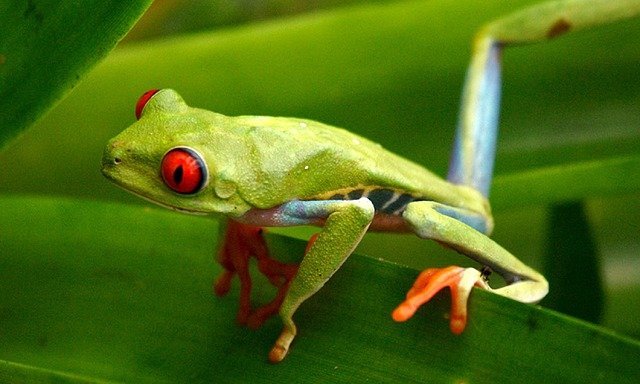Red-eyed tree frogs are beautiful creatures, but they can be very delicate and difficult to care for, especially for people who have never owned a frog before. One of the biggest problems they might face is becoming overweight or obese. You may be asking how to tell if my tree frog is overweight.
Well, first, they’ll get an appearance known as a “dumpy frog” look. You’ll be able to see fat layers on top of their head and body, sometimes even covering the eyes.
In the wild, it’s very uncommon for a red-eyed tree frog to become overweight because they expend so much energy trying to chase after insects to eat. In captivity, though, they tend to be less active and may also eat more, both of which can contribute to obesity.
How to Keep Your Frog from Becoming Overweight
Frogs are not the kind of pet that you should play with or handle frequently, so you can’t train them or give them exercise the same way you would other pets. However, there are a few ways that you can keep your red-eyed tree frog at a healthy weight. The first is, of course, to make sure that the frog has plenty of things to keep them active by filling their enclosure with lots of plants and branches (both real and fake) for them to climb on and hop between.
Other ways to promote exercise and weight loss are to enlarge the frog’s enclosure or raise the habitat’s temperature. Just make sure not to exceed the recommended temperature range. For red-eyed tree frogs, the preferred daytime temperature is 75-85 degrees Fahrenheit and the nighttime temperature should be 68-75 degrees. Keeping the heat level at the upper end of those ranges can accelerate the frog’s metabolic rate and calorie use.
These are more passive strategies, but the part you have the most control over is the frog’s diet. Overeating is one of the biggest causes of obesity in pet red-eyed tree frogs. They are insectivores that primarily eat live bugs such as crickets, mealworms, wax worms, phoenix worms, and others.
[su_box title=”Our Red-eyed tree frog guide.”]We hope we have answered your question fully today regarding the question of whether or not your tree frog is overweight. However, there is so much more you should be aware of concerning the health and welfare of these wonderful creatures. It was that reason we put the most concise guide on red-eyed tree frog keeping. You must have a look. Just Click Here.[/su_box]
Choosing the correct diet.
That wide array of options is very important, though it may not always be easy to find various bugs at a pet store. If possible, try to give them a varied diet that includes many different kinds of bugs. After all, you wouldn’t want to eat the same thing every day, would you? Neither does your frog. Different kinds of insects provide different nutrients that the red-eyed tree frog needs, so giving them too much or too little of one thing can lead to health issues, including obesity.
For example, wax worms, while they are still an important part of the red-eyed tree frog’s diet, are high in fat. A diet that consists of mainly these types of worms could be the reason behind your frog’s chubbiness.
Another thing to keep in mind is not only the type of food you’re feeding your frog but also the number of times you feed them. Juvenile red-eyed tree frogs can be fed once a day, preferably at night when they’re the most active. Adults, however, should be fed less frequently, about 2-3 insects once every other day.
It’s very easy for a frog in captivity to begin overeating, as they are not picky and will eat just about anything. That’s why it’s a good idea to control the portion sizes you give them.
Do You Need to Take an Overweight Red-Eyed Tree Frog to the Vet?
Generally, no. If you think your frog might be overweight, it’s not necessary to take them to the vet. Instead, you can simply change up the amount of food you give them at each feeding or avoid giving them insects that are high in fat for a while.
However, if you don’t notice any difference in your frog’s appearance after you’ve made changes to their diet or they begin to behave strangely, it’s best to take them to a veterinarian that specializes in exotic pets. They will be able to examine the frog and give it medicine or treatment if it’s sick. They’ll also give you advice on how to adjust your frog’s diet or habitat to promote weight loss if necessary.
Remember that an overweight frog should have obvious fat layers on its head and body. If instead, it looks as though it’s inflated like a balloon, that means the frog is bloated, not overweight. In that case, you do need to take the frog to the vet because bloating can be a symptom of many different health problems, including infections and diseases that you can’t fix without professional help.
We hope this has been helpful, and we wish you luck taking care of your froggy friend!




